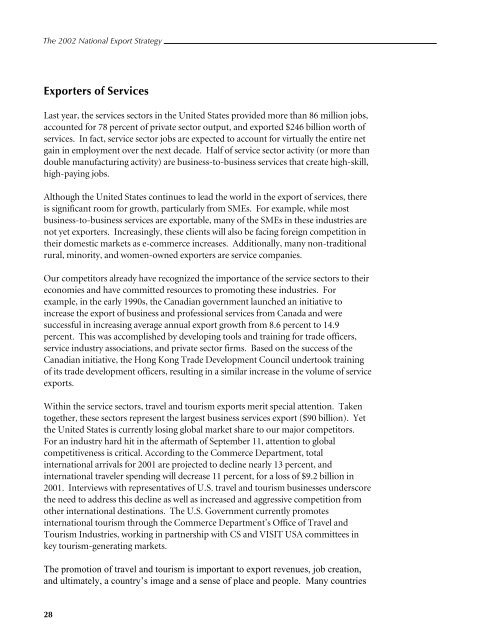National Export Strategy 2002 - International Trade Administration ...
National Export Strategy 2002 - International Trade Administration ...
National Export Strategy 2002 - International Trade Administration ...
Create successful ePaper yourself
Turn your PDF publications into a flip-book with our unique Google optimized e-Paper software.
The <strong>2002</strong> <strong>National</strong> <strong>Export</strong> <strong>Strategy</strong><br />
<strong>Export</strong>ers of Services<br />
Last year, the services sectors in the United States provided more than 86 million jobs,<br />
accounted for 78 percent of private sector output, and exported $246 billion worth of<br />
services. In fact, service sector jobs are expected to account for virtually the entire net<br />
gain in employment over the next decade. Half of service sector activity (or more than<br />
double manufacturing activity) are business-to-business services that create high-skill,<br />
high-paying jobs.<br />
Although the United States continues to lead the world in the export of services, there<br />
is significant room for growth, particularly from SMEs. For example, while most<br />
business-to-business services are exportable, many of the SMEs in these industries are<br />
not yet exporters. Increasingly, these clients will also be facing foreign competition in<br />
their domestic markets as e-commerce increases. Additionally, many non-traditional<br />
rural, minority, and women-owned exporters are service companies.<br />
Our competitors already have recognized the importance of the service sectors to their<br />
economies and have committed resources to promoting these industries. For<br />
example, in the early 1990s, the Canadian government launched an initiative to<br />
increase the export of business and professional services from Canada and were<br />
successful in increasing average annual export growth from 8.6 percent to 14.9<br />
percent. This was accomplished by developing tools and training for trade officers,<br />
service industry associations, and private sector firms. Based on the success of the<br />
Canadian initiative, the Hong Kong <strong>Trade</strong> Development Council undertook training<br />
of its trade development officers, resulting in a similar increase in the volume of service<br />
exports.<br />
Within the service sectors, travel and tourism exports merit special attention. Taken<br />
together, these sectors represent the largest business services export ($90 billion). Yet<br />
the United States is currently losing global market share to our major competitors.<br />
For an industry hard hit in the aftermath of September 11, attention to global<br />
competitiveness is critical. According to the Commerce Department, total<br />
international arrivals for 2001 are projected to decline nearly 13 percent, and<br />
international traveler spending will decrease 11 percent, for a loss of $9.2 billion in<br />
2001. Interviews with representatives of U.S. travel and tourism businesses underscore<br />
the need to address this decline as well as increased and aggressive competition from<br />
other international destinations. The U.S. Government currently promotes<br />
international tourism through the Commerce Department’s Office of Travel and<br />
Tourism Industries, working in partnership with CS and VISIT USA committees in<br />
key tourism-generating markets.<br />
The promotion of travel and tourism is important to export revenues, job creation,<br />
and ultimately, a country’s image and a sense of place and people. Many countries<br />
28
















